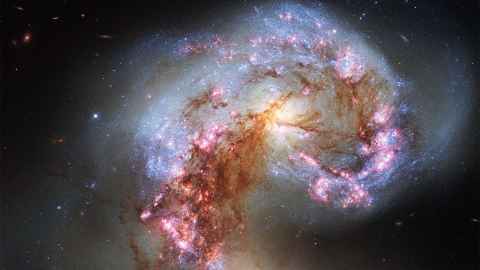A new discovery in an ancient galaxy
4 February 2021
Opinion: The discovery of nine stars in an ancient galaxy opens new prospects to study the early universe and giant dark matter, explains Heloise Stevance.

An international team of researchers has detected a giant dark matter halo in one of the most ancient galaxies in orbit around the Milky Way.
With its 100 to 400 billion stars, large spiral arms, and abundance of bright young regions, our galaxy is one of the larger ones. Like other spirals with ongoing star formation, the matter in its gas and dust has been enriched over time with elements that could not be created in the Big Bang; they had to be formed deep in the heart of stars and their fiery deaths.
And then there is Tucana II.
Tucana II is an ultra-faint dwarf 一 these types of the galaxies are over a million times fainter than our own and they are what remains of some of the earliest galaxies in the cosmos. The problem with being so faint, however, is that they can be very difficult to study. After all, astronomy relies almost exclusively on being able to capture the light of the objects we seek to understand.
But when there is a will, there is a way, and on February 1, a team of researchers published in Nature Astronomy new observations of Tucana II with the Australian National University (ANU) SkyMapper combined with data from the Gaia space telescope. Taking advantage of the special filters on the ANU SkyMapper, they were able to identify nine new stars in Tucana II with extremely low chemical enrichment, firmly asserting the status of this dwarf galaxy as the most metal-poor galaxy known to astronomers. Over a thousand times less enriched in heavy elements than the solar neighbourhood, its composition is very close to that of the universe immediately after the Big Bang, over 13 billion years ago.
The piece-de-resistance however is not the composition of the nine stars but their location. Found deep in the outskirts of Tucana II, they are twice as far from the core of their host as any other star previously identified in that type of galaxy. The question then naturally poses itself, why are they so far away from the galactic centre?
The most obvious answer could be a recent merger with another galaxy - in that scenario the tidal interactions caused by the collision can draw stars outward, distorting the shape of the galaxies (as seen in the photo above). It is a simple and elegant solution, and it is also wrong. The merger scenario is not consistent with some of the key characteristics of Tucana II, including the speed at which the stars travel through space.
The only other explanation then is dark matter. These nine stars were not pulled away from their home, their home is simply much larger than expected. What brings together the gas, dust and stars in galaxies is gravity, and gravity is “powered” by mass.
Astronomers have long known that most of the mass content in galaxies is actually made of matter that does not shine, which is quantified using the so-called mass-to-light ratio. An ordinary and sensible order of magnitude for the mass-to-light ratio would be around 100, meaning that for every solar luminosity in a galaxy there are 100 solar masses of matter. In other words, for every sun that shines, there are 99 solar masses of “stuff” floating around in the dark. That stuff can be gas, dust and, of course, more exotic and as-of-yet-unknown dark matter.
But by now you will have realised that Tucana II is neither ordinary nor sensible, and its mass-to-light ratio is nowhere close to 100, it is a whooping 2000. Within 3000 light years from the centre of Tucana II reside an impressive 20 million solar masses worth of dark matter and a mere 10 thousand solar masses worth of stars, and the nine stars found in the outskirts of the dwarf galaxy can only be kept in such a wide orbit by the pull and tug of the giant dark matter halo.
This discovery is amazing, but to tell you the truth it is not totally unexpected. Massive dark matter halos in ancient dwarf galaxies have actually been predicted by astronomers, but until now they could not be measured owing to the extremely low luminosities of these objects. These findings, and the methods developed along the way, open up new prospects to study these not-so-tiny artifacts of the early universe and their giant dark matter “clouds”.
Dr Heloise Stevance is a research fellow in the Department of Physics.
This article reflects the opinion of the author and not necessarily the views of the University of Auckland.
Used with permission from Newsroom A new discovery in an ancient galaxy 4 February 2021.
Media queries
Alison Sims | Research Communications Editor
DDI 09 923 4953
Mob 021 249 0089
Email alison.sims@auckland.ac.nz